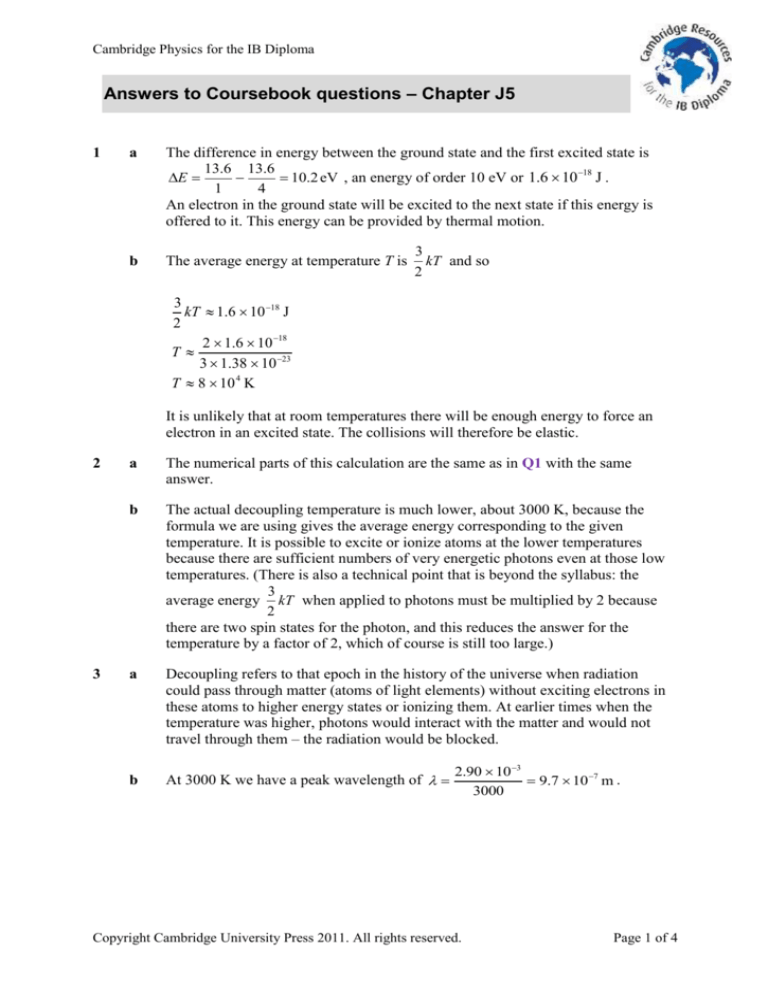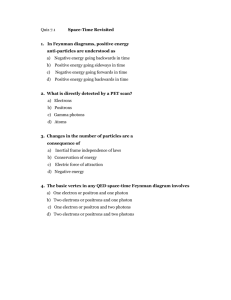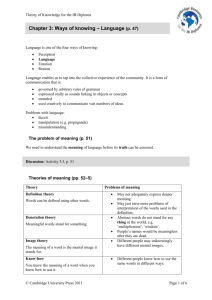
Cambridge Physics for the IB Diploma
Answers to Coursebook questions – Chapter J5
1
a
The difference in energy between the ground state and the first excited state is
13.6 13.6
E
10.2 eV , an energy of order 10 eV or 1.6 10 18 J .
1
4
An electron in the ground state will be excited to the next state if this energy is
offered to it. This energy can be provided by thermal motion.
b
The average energy at temperature T is
3
kT and so
2
3
kT 1.6 10 18 J
2
2 1.6 10 18
T
3 1.38 10 23
T 8 10 4 K
It is unlikely that at room temperatures there will be enough energy to force an
electron in an excited state. The collisions will therefore be elastic.
2
3
a
The numerical parts of this calculation are the same as in Q1 with the same
answer.
b
The actual decoupling temperature is much lower, about 3000 K, because the
formula we are using gives the average energy corresponding to the given
temperature. It is possible to excite or ionize atoms at the lower temperatures
because there are sufficient numbers of very energetic photons even at those low
temperatures. (There is also a technical point that is beyond the syllabus: the
3
average energy kT when applied to photons must be multiplied by 2 because
2
there are two spin states for the photon, and this reduces the answer for the
temperature by a factor of 2, which of course is still too large.)
a
Decoupling refers to that epoch in the history of the universe when radiation
could pass through matter (atoms of light elements) without exciting electrons in
these atoms to higher energy states or ionizing them. At earlier times when the
temperature was higher, photons would interact with the matter and would not
travel through them – the radiation would be blocked.
b
At 3000 K we have a peak wavelength of
2.90 10 3
9.7 10 7 m .
3000
Copyright Cambridge University Press 2011. All rights reserved.
Page 1 of 4
Cambridge Physics for the IB Diploma
4
3
kT or 3kT (see comment for Q2) as the average photon energy
2
3
3
we get kT 1.38 10 23 3 6 10 23 J 4 10 4 eV
2
2
or 3kT 3 1.38 1023 3 12 1023 J 8 104 eV .
a
Using
b
The peak wavelength at 3 K is
2.90 10 3
9.7 10 4 m .
3
The energy of such a photon is
hc 6.63 1034 3 108
E
2 1022 J 1103 eV
4
9.7 10
and is comparable to the estimates in (a).
c
The energy is small but it is absorbed by a very large number of water molecules.
5
See Q3.
6
a
This is shown in the answers on page 818 in Physics for the IB Diploma.
b
With a rest energy of about 80 GeV, to produce two W bosons requires a photon
energy of about 160 GeV. A photon would have this energy at a temperature T
given by
3
kT 160 GeV 2.6 10 8 J
2
2 2.6 10 8
T
3 1.38 10 23
T 1 1015 K
c
The energy at temperature T used above is the average energy.
Even at lower energies there would be occasionally sufficient energy to produce
the Ws not only at rest but also moving, i.e. with kinetic energy.
7
The matter would annihilate the antimatter into an enormous amount of radiation.
8
It is believed that in the very early universe there were almost equal numbers of
particles and antiparticles, with a very slight excess of particles (one extra particle for
every 1010 particle antiparticle pairs). At the high temperatures of the early universe
two types of reactions took place: particles colliding with antiparticles and annihilating
into radiation, and radiation materializing into particle–antiparticle pairs. As the
temperature fell, it was no longer possible for the second reaction to take place since
the radiation no longer had the energy to cause particle antiparticle pairs to be created
out of the vacuum. The reverse process continued, however, resulting in the
annihilation of particle antiparticle pairs. What was left is the matter we see today.
Copyright Cambridge University Press 2011. All rights reserved.
Page 2 of 4
Cambridge Physics for the IB Diploma
9
a
The available energy is 2 270 540GeV .
b
This corresponds to a temperature of:
3
kT 540 GeV 8.6 10 8 J
2
2 8.6 10 8
T
3 1.38 10 23
T 4 1015 K
The universe was about 10 12 s old at this temperature.
c
10
The energy available during these collisions corresponds to a very high
temperature, comparable to the temperatures of the early universe. In this way,
the conditions prevailing during the collisions are similar to the conditions of the
early universe.
Calculations in particle physics come up with infinite answers when Feynman diagrams
involving loops are calculated, such as, for example, a photon materializing into an
electron–positron pair that subsequently annihilates to produce the photon again:
It has been possible to remove these infinities and obtain finite, physically meaningful
answers by a process called renormalization. This same method fails completely when
applied to gravitation.
11
It is believed that at the very early universe the energies available were so enormous
that one can no longer use a classical theory of gravity, as quantum effects would
become important for gravitation as well. The energy, distance scale and the time at
which this happens are taken to be the Planck scale for energy, distance and time. These
numbers are formed from the basic constants of physics and are:
E
hc5
1019 GeV
G
L
hG
1035 m
c3
t
hG
1043 s
5
c
Copyright Cambridge University Press 2011. All rights reserved.
Page 3 of 4
Cambridge Physics for the IB Diploma
12
String theories differ in that the basic ingredients are one-dimensional objects
called strings rather than point particles. Another difference is that they are
formulated in many dimensions and not just the 4 dimensions of ordinary
particle physics.
13
The main reason is that they can perhaps provide a quantum theory of gravitation –
something that has eluded physicists for decades – as well as for unified theory of
interactions.
The problem seems to be that interactions in particle physics take place at a point, and
this is what creates the infinities. A point particle traces out a line as time passes:
and an interaction takes place at a point:
interaction point
A closed string, on the other hand, traces out a two-dimensional surface as time passes:
surface
string
and interactions are not at a point:
interaction
region
14
The extra dimensions are believed to curl up and form a closed space, they do not
extend indefinitely as the usual space dimensions we are familiar with.
The size of the closed space formed by these extra dimensions is expected to be
microscopically small – we would be unaware of them at ordinary energies.
Copyright Cambridge University Press 2011. All rights reserved.
Page 4 of 4










